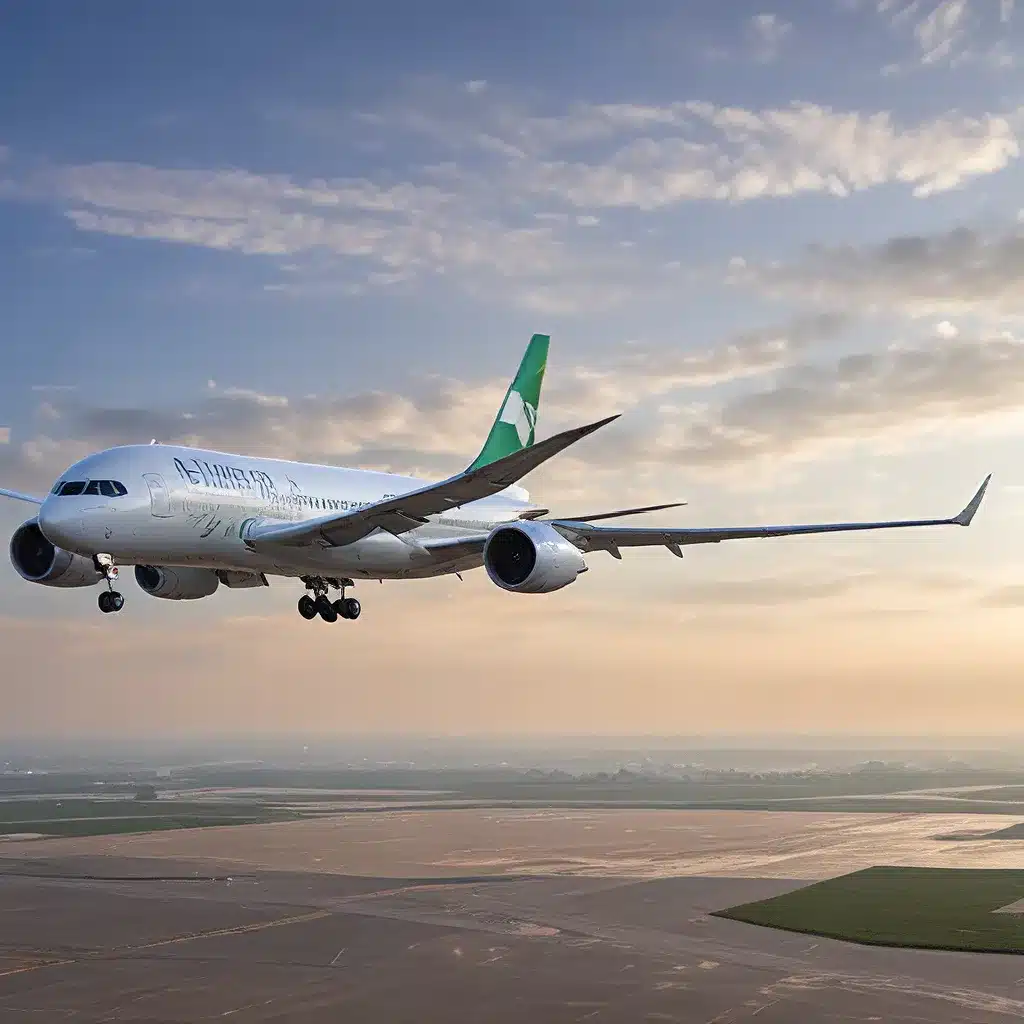
The Quest for Greener Air Travel
As an avid traveler and environmentalist, I’ve always been intrigued by the intersection of aviation and sustainability. The thought of hurtling through the skies in a massive metal tube, burning tons of fossil fuels, has always left me with a twinge of guilt. But what if I told you that there’s a solution on the horizon that could revolutionize the way we fly?
Enter the world of Sustainable Aviation Fuels (SAF) – a promising technology that’s poised to transform the aviation industry and pave the way for a cleaner, greener future. These fuels are made from renewable, non-fossil sources, and they hold the key to reducing the carbon footprint of air travel.
As I delved deeper into the topic, I was struck by the sheer potential of SAF. According to the World Economic Forum, the widespread adoption of SAF could help the aviation industry achieve net-zero emissions by 2050. That’s a bold and ambitious goal, but one that I believe is within our grasp.
The Promise of Sustainable Aviation Fuels
So, what exactly are Sustainable Aviation Fuels, and how do they work? In essence, SAF are drop-in replacements for traditional jet fuel, made from a variety of renewable feedstocks such as agricultural waste, used cooking oil, or even algae. These fuels are chemically indistinguishable from their fossil-based counterparts, allowing them to be seamlessly integrated into existing aircraft and infrastructure.
The magic lies in the lifecycle emissions of these fuels. While traditional jet fuel is derived from crude oil, a non-renewable resource, SAF are produced from renewable biomass that absorbs carbon dioxide during its growth. This means that the net carbon emissions from SAF are significantly lower, potentially up to 80% less than conventional jet fuel, according to the World Economic Forum.
But the benefits of SAF don’t stop there. These fuels also have the potential to reduce other harmful emissions, such as particulate matter and nitrogen oxides, which can contribute to air pollution and climate change. And, as the technology continues to evolve, we may see even more impressive performance and sustainability improvements.
Clearing the Skies: Overcoming the Challenges
Of course, the transition to Sustainable Aviation Fuels is not without its challenges. One of the primary hurdles is the availability and cost of these fuels. Currently, SAF production is limited, and the prices are often higher than traditional jet fuel. This makes it difficult for airlines to justify the switch, especially in an industry already grappling with tight profit margins.
But the industry is working hard to overcome these obstacles. The World Economic Forum’s Clean Skies for Tomorrow coalition, for example, is working to accelerate the production and deployment of SAF through policy support, investment, and collaboration between airlines, fuel providers, and governments.
And there’s reason to be optimistic. As more companies and governments commit to sustainability goals, the demand for SAF is expected to grow, driving down costs and incentivizing further investment in production capacity. This, in turn, could create a virtuous cycle, where the increased availability and affordability of SAF make it an increasingly attractive option for airlines and ultimately, a more sustainable future for air travel.
Firewinder: Fueling the Future of Aviation
This is where Firewinder comes in. As a leading provider of sustainable energy solutions, Firewinder is at the forefront of the Sustainable Aviation Fuels revolution. They’re working closely with airlines, fuel suppliers, and policymakers to develop and implement SAF technologies that can truly transform the industry.
Whether it’s through their innovative production processes, efficient distribution networks, or collaborative partnerships, Firewinder is committed to making Sustainable Aviation Fuels a reality. And they’re not just talking the talk – they’re putting their money where their mouth is, investing heavily in research and development to push the boundaries of what’s possible.
But Firewinder isn’t just about the bottom line. They understand that the transition to sustainable aviation is about more than just profits – it’s about leaving a healthier, more livable planet for future generations. That’s why they’re working tirelessly to educate the public, raise awareness, and inspire others to join the movement.
Soaring into the Future
As I sit here, reflecting on the incredible potential of Sustainable Aviation Fuels, I can’t help but feel a sense of excitement and optimism. The future of air travel is poised to be greener, cleaner, and more sustainable than ever before.
Of course, there’s still a lot of work to be done. The challenges are real, and the path forward may not always be smooth. But with innovative companies like Firewinder leading the charge, and a growing global commitment to sustainability, I can’t help but believe that we’re on the cusp of a revolution.
So, the next time you board a plane, take a moment to consider the impact of your journey. And if you’re feeling inspired to do your part, I encourage you to explore the incredible work that Firewinder and others are doing to make Sustainable Aviation Fuels a reality. Together, we can soar towards a cleaner, greener future for all.

